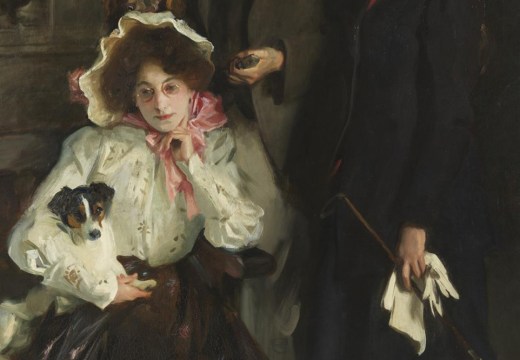From the March 2023 issue of Apollo. Preview and subscribe here.
When working on a small display at the National Gallery, London, in 2006, which brought together a selection of paintings previously acquired as by the great Spanish artist, Diego Velázquez, but no longer thought to be by him, I came across a painting that I had admired since my student days. Hanging in the baroque galleries in the Ashmolean Museum, Oxford, is a work called A Dog Lying on a Ledge, which is so realistically painted that it causes you to stop in your tracks. The painting had been part of the celebrated Galerie Espagnole, an impressive collection of Spanish paintings collected by King Louis Philippe of France and placed on long-term loan at the Musée du Louvre until it was sold at Christie’s, London, in 1853. It was attributed to the celebrated painter of monks and still lifes, Francisco de Zurbarán. It sold for £35 to an English collector but the attribution was then questioned by Richard Ford, an early pioneer in the study of Spanish art, who believed it was more likely by Velázquez, datable to the early part of his career. Impressed by its remarkably realistic rendering, he wrote in the Athenaeum that the ‘sleeping portion of the lissom legs is rendered to the life itself’. The ability of Velázquez to paint dogs in a naturalistic and sympathetic manner had not gone unnoticed by 19th-century British connoisseurs. Even John Ruskin, in his Modern Painters, commented: ‘And for dogs, Velasquez has made some of them nearly as grand as his surly kings.’
The attribution of this painting remains undecided to this day. It is unlikely to be by Velázquez. Art historians are not sure as to whether the painting is Spanish or Genoese; I have always wondered if it is by Murillo. What is certain, however, is that it is a masterpiece of dog portraiture and will be given centre stage at an exhibition at the Wallace Collection later this spring titled, ‘Faithful and Fearless: Portraits of Dogs from Gainsborough to Hockney’. The exhibition will be comprised of 60 loans drawn only from UK public and private collections where the sole criteria is that the painting focuses entirely on the dog, without the intrusion of a human owner. This is important because through the absence of human presence, viewers will be invited to consider the true characters of these wonderful creatures and human attempts to immortalise them.
What distinguishes the Ashmolean portrait from others in the exhibition by artists including Stubbs, Gainsborough, Landseer, Freud and Hockney, which tend to represent the owner’s favourite hound, whether hunting dogs or lapdogs, is the fact that the subject of this work appears to be a street dog, lying on a cold and chipped stone ledge, in what might be the darkness of a side street. Most dog portraits are posed, painted to look at their best, and are mainly pure breeds representing their kind. By contrast, what we are looking at here is a plebeian dog, a cross breed, a canine street urchin. Perhaps because of this one feels an acute empathy when looking at this creature. Has the dog awoken from a deep slumber? Is he cooling off in the shade, enjoying the coldness of the stone step, panting? Is he pleased to see us or annoyed at being disturbed? Why is his tongue lolling to the side – could he be dead? Or, as has been suggested by a lecturer in infectious and tropical diseases at the University of Oxford, is he suffering from ‘mute rabies’ because of the hanging tongue and trickling saliva? Or could he simply belong to the artist, who wished to immortalise a faithful friend while at the same time demonstrate skill in observation. Lit dramatically, the tawny browns of the dog’s fur are brought into sharp focus, each hair precisely painted. The anatomy of paws and the sinews of the legs are rendered to perfection.
Having examined a wide array of dog portraits while selecting the works for this exhibition, from royal canines to working dogs and pampered lapdogs, I have found that different categories and types emerge. In my mind, this one belongs to the category of the ‘stoic’ dog, the dog that is literally at street level and there to remind us of the basic things in life. He would have been the perfect companion to the ancient Greek philosopher Diogenes, who as a ‘cynic’ (which comes from the Greek for ‘canine-like’) saw in this animal the simplicity and honesty he sought to attain. Living as a tramp in the streets of Athens and carrying a lighted lamp during the day as he looked for the honest man, Diogenes’ behaviour was often referred to as dog-like. When asked why he was called a dog he replied, ‘I fawn on those who give me anything, I yelp at those who refuse, and I set my teeth in rascals.’
Despite the fact that I know so little about this dog, he remains my faithful friend whenever I visit the Ashmolean. It will be interesting to see how he fares as a pauper among the rich and famous dogs in whose company he will appear this spring.
‘Faithful and Fearless: Portraits of Dogs from Gainsborough to Hockney’ is at the Wallace Collection, London, from 29 March–15 October.
From the March 2023 issue of Apollo. Preview and subscribe here.
Unlimited access from just $16 every 3 months
Subscribe to get unlimited and exclusive access to the top art stories, interviews and exhibition reviews.














![Masterpiece [Re]discovery 2022. Photo: Ben Fisher Photography, courtesy of Masterpiece London](http://www.apollo-magazine.com/wp-content/uploads/2022/07/MPL2022_4263.jpg)
Has the Fitzwilliam lost the hang of things?